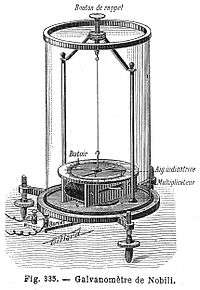Leopoldo Nobili
| Leopoldo Nobili | |
|---|---|
 | |
| Born |
5 July 1784 Trassilico |
| Died |
22 August 1835 (aged 51) Florence |

Leopoldo Nobili, born on 5 July 1784[1] in Trassilico (Toscana) and died on 22 August 1835[1] in Florence, was an Italian physicist who invented a number of instruments critical to investigating thermodynamics and electrochemistry.
Born Trassilico, Garfagnana, after attending the Military Academy of Modena he became an artillery officer. He was awarded the Légion d'honneur for his service in Napoleon's invasion of Russia.
In 1825 he developed the astatic galvanometer.[2]
He worked with Macedonio Melloni on the thermomultiplier, a combination of thermopile and galvanometer, before being appointed professor of physics at the Regal Museum of Physics and Natural History in Florence where he worked with Vincenzo Antinori on electromagnetic induction.
He was also credited with the discovery of 'Nobili's Rings'. "When a dilute solution of copper acetate is placed on a bright silverplate and a strip of zinc is touched to the silver beneath the copper, a series of rings of copper are formed by electrolysis around the zinc."[3]
References
- 1 2 Schettino, E. "NOBILI, Leopoldo". Dizionario Biografico degli Italiani. Enciclopedia Italiana. Retrieved 31 August 2015.
- ↑ Greenslade, Thomas. "Instruments for Natural Philosophy — Astatic Galvanometer". Kenyon College. Retrieved 2010-12-19.
- ↑ Thomas O'Conor Sloane, The Standard Electrical Dictionary: A Popular Dictionary of Words and Terms, London 1898, p. 392